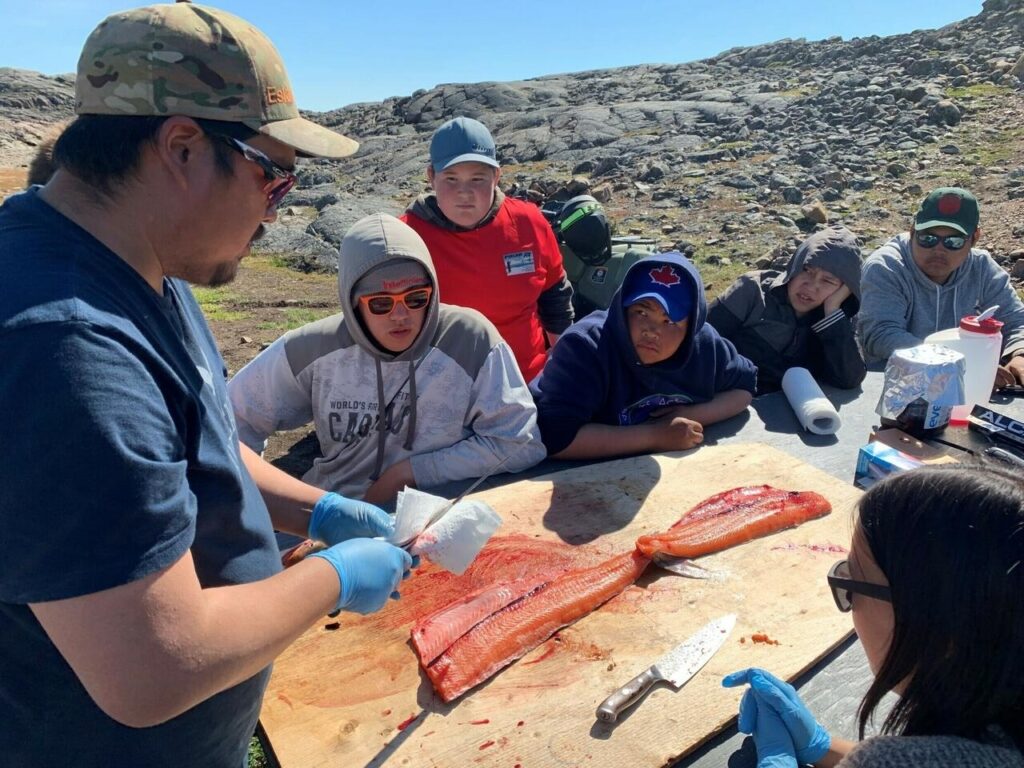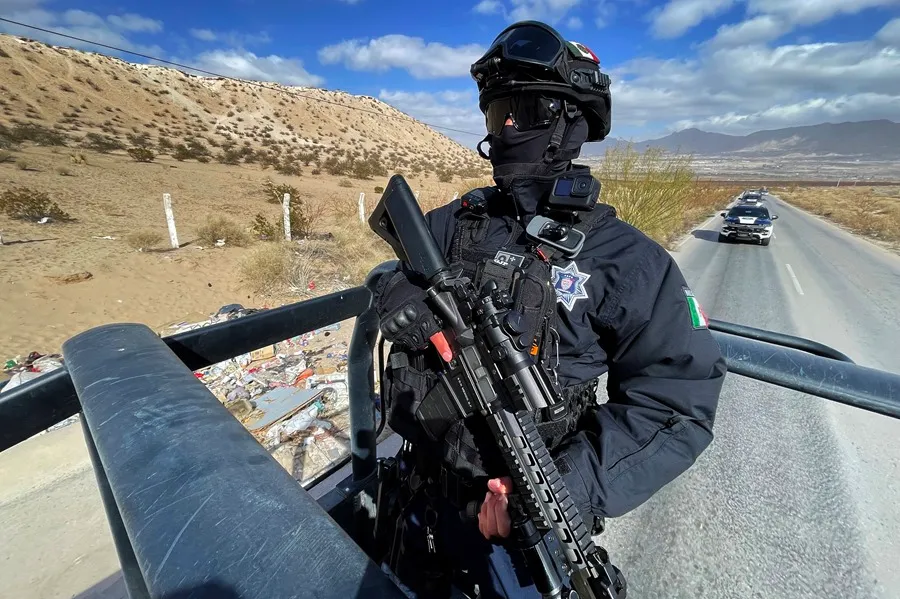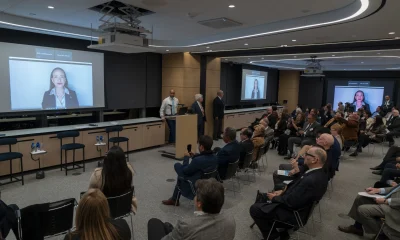International
In Canada’s Arctic, Inuit traditions help combat youth depression

AFP | by Anne-Sophie THILL
Filleting a fish, lighting a fire or building an igloo: In Canada’s Arctic, Inuit youth are being encouraged to connect with their culture in an attempt to prevent severe depression and save lives.
A dozen teenagers and young adults gather around instructor Alex Flaherty. They don’t want to miss any of the traditional hunter’s precise gestures as he carves a fish or lights a fire.
“Our culture has changed so much in the last 50 years when people used to live in igloos… the change is happening so fast, (and) we are losing our culture,” he tells AFP.
Flaherty blames the societal shifts for a series of social ills such as violent crime, substance abuse and a high rate of suicide.
Hoping to help remedy these problems, he’s taken hundreds of teenagers hiking, camping and hunting in the vast tundra in the past three years.
In addition to keeping alive Inuit culture, his government-funded Polar Outfitting program also aims to bolster young people’s mental health and teach them to adapt to a changing climate — in a region that is warming much faster than elsewhere.
Flaherty says he takes mostly youth aged 12 to 20 years old, “because that’s when their lifestyle starts changing (and) when they need help.”
In the summer, they hike across the rocky, windswept lands near the bay city of Iqaluit that is home to some 7,000 residents — and is accessible only by plane most months.
They also learn to make fishing nets to catch Arctic char and to navigate and survive in the pristine but unforgiving environment.
In the dead of winter, when sunlight is reduced to just a few hours per day, they will go out on the ice to fish, and build igloos.
‘Not just about fishing’
At 22, Annie Kootoo is the oldest in the current class. She gushes with joy after spending 10 days in the wilderness.
“I did a lot of activities that I don’t usually do, and it’s been very helpful for my mental health,” she says.
Chris Laisa, a 14-year-old echoes the sentiment. “I feel great,” he says after a lesson.
“It was fun because I learned how to fillet a fish, how to prepare it.”
Flaherty, standing nearby, adds that it’s “not just about fishing. It’s about clearing your mind, being outdoors and sharing with others.”
In the Nunavut territory of northern Canada, where the average age is 28, young people are deeply affected by the isolation and intergenerational traumas caused by past colonial policies.
Like many Indigenous peoples in Canada, the Inuit are haunted by memories of being forced into residential schools where they were stripped of their language and culture, and abused by teachers and headmasters.
Here the suicide rate is much higher than the rest of the country — 76.6 per 100,000 inhabitants in 2020 compared to 10.1, according to Statistics Canada.
Camilla Sehti, the Nunavut government’s head of mental health and addictions services, goes through a long list of what’s contributed to the crisis: “It’s just so many factors.”
Healing, she says, “starts with reconnecting people to their culture.”
“I think colonization had a huge impact on this territory and the ability for people to feel connected to self,” she explains, describing new mental health initiatives that emphasize “family, culture and community.”
After losing her best friend two years ago, Minnie Akeeagok started posting warnings on social media about depression and suicide.
“Everybody in Nunavut knows someone who has committed suicide or faced mental health issues. I personally know more than five,” the 18-year-old told AFP.
“We need more resources, more accessibility within the mental health field in Nunavut,” she says, noting that in the far off communities of this Arctic territory the situation is even more dire.
Central America
Mexico and Guatemala launch joint security operation after Agua Zarca border attack

The Government of Mexico announced on Tuesday that it has strengthened coordination with Guatemala following an armed confrontation in the community of Agua Zarca, in Guatemala’s Huehuetenango department, where a soldier was wounded in an attack attributed to organized-crime groups operating on both sides of the border.
The Secretary of Security and Citizen Protection, Omar García Harfuch, confirmed that Mexico is exchanging information with Guatemalan authorities and that Mexican Army units have been deployed along the border to reinforce surveillance and assist in reconnaissance operations.
The attack, Guatemala’s Defense Ministry stated, reflects the “criminal dynamics” dominating that border region, where different groups compete for drug and arms trafficking routes.
According to Guatemala’s Defense Ministry, the clash left a soldier wounded in the leg after suspected criminals crossed from Mexico and opened fire. The wounded soldier is reportedly in stable condition. Authorities also seized high-caliber weapons, explosives, tactical gear and drones, which were handed over for forensic analysis.
Mexican Defense Secretary General Ricardo Trevilla Trejo announced that a coordinated plan of operations will be launched involving both Mexican and Guatemalan forces along the border to counter these criminal networks.
Harfuch emphasized that the violence is not isolated but symptomatic of the ongoing struggle between criminal organizations for territorial control, and reiterated Mexico’s commitment to bilateral security cooperation and its intention to strengthen institutional presence in vulnerable border zones.
International
Zelensky meets Pope Leo XIV as review of U.S. peace plan continues

Ukrainian President Volodymyr Zelensky met on Tuesday with Pope Leo XIV in Italy, after pledging to deliver a response to the United States regarding the proposed peace plan aimed at ending the war with Russia.
The meeting with the pontiff took place at the papal residence in Castel Gandolfo, near Rome, where Leo XIV “reiterated the need to continue dialogue and renewed his urgent hope that the ongoing diplomatic initiatives may lead to a just and lasting peace,” the Vatican said in a statement.
His visit to Italy follows Monday’s meetings with European leaders in London and Brussels, amid pressure from U.S. President Donald Trump to agree to a peace plan that Zelensky said he is still reviewing.
According to Zelensky, the plan presented by Washington—originally consisting of 28 points—was reduced to 20 after discussions between Ukrainian and U.S. representatives over the weekend. “We are going to work on those 20 points. We are not completely satisfied with the proposals from our partners,” Zelensky said during an online press conference on Monday.
International
Japan lifts tsunami alert after strong 7.6-magnitude earthquake hits northern coast

A powerful 7.6-magnitude earthquake struck Japan’s northern coast on Monday, triggering several tsunami waves of up to 70 centimeters, authorities said. The tsunami alert was lifted in the early hours of Tuesday.
According to the U.S. Geological Survey (USGS), the quake occurred at 11:15 p.m. local time (14:15 GMT) off the coast of Misawa, at a depth of 53 kilometers. Japan’s Meteorological Agency (JMA) immediately issued a tsunami warning. The first wave reached a port in Aomori Prefecture at 11:43 p.m. (14:43 GMT), followed by others measuring up to 70 centimeters.
Public broadcaster NHK reported that an employee at a hotel in the city of Hachinohe confirmed that several people were injured. Live footage showed shattered glass scattered across roads, while many residents evacuated to the city hall seeking shelter.
The strong tremor was also felt in Sapporo, where emergency alerts were sent to residents’ mobile phones. A reporter in Hokkaido described a horizontal shaking that lasted around 30 seconds, making it difficult to stay standing.
Before the alert was lifted, the JMA had warned of the possibility of tsunami waves up to three meters high along Japan’s Pacific coast. Government spokesperson Minoru Kihara urged residents to remain in safe areas until the warning was officially lifted.
-

 Central America2 days ago
Central America2 days agoGuatemalan soldier wounded in clash with suspected mexican armed group near border
-

 International5 days ago
International5 days agoCatalonia’s president calls for greater ambition in defending democracy
-

 International2 days ago
International2 days agoJapan lifts tsunami alert after strong 7.6-magnitude earthquake hits northern coast
-

 International4 days ago
International4 days agoFive laboratories investigated in Spain over possible African Swine Fever leak
-

 Central America4 days ago
Central America4 days agoHonduras vote vount drags on as Asfura and Nasralla remain in technical tie
-

 Central America2 days ago
Central America2 days agoGuatemala reverses asset seizures after judge replacement, benefiting ex-president and former ministers
-

 International5 days ago
International5 days agoMaría Corina Machado says Venezuela’s political transition “must take place”
-

 Central America17 hours ago
Central America17 hours agoMexico and Guatemala launch joint security operation after Agua Zarca border attack
-

 International2 days ago
International2 days agoInterior Dept. redefines 2026 Patriotic Days, sparking criticism over removed civil rights holidays
-

 Central America17 hours ago
Central America17 hours agoHonduran University: Nullifying elections without proof of fraud undermines popular sovereignty
-

 Central America17 hours ago
Central America17 hours agoCNA director says Libre’s defeat stems from “lack of substance,” not messaging
-

 International17 hours ago
International17 hours agoZelensky meets Pope Leo XIV as review of U.S. peace plan continues


























